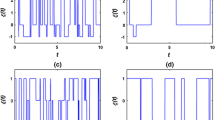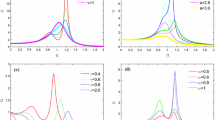Abstract
We investigate stochastic resonance in an underdamped linear system subjected to multiplicative trichotomous noise. We carry out the Shapiro–Loginov formula to find the exact expression of output amplitude gain, and the impacts of the input signal frequency and noise parameters will be observed, such as noise switching rate or noise correlation time, noise amplitude and noise flatness. Then one can find the stochastic resonance for the proposed linear system.
Similar content being viewed by others
Explore related subjects
Discover the latest articles, news and stories from top researchers in related subjects.Avoid common mistakes on your manuscript.
1 Introduction
Effects of random noise have been considered by a number of investigators, and it has been found that in nonlinear systems transitions including generation or suppression of bifurcation or chaos can be induced by different kinds of noise [1], such as Gaussian white noise, non-Gaussian Levy noise and colored noise [2–4].
Stochastic resonance (SR) is just a kind of synergistic effect driven by a periodic signal which was proposed by Benzi to explain the cycle changes of ancient climates [5]. At present, SR has been used successfully in many different fields [6–8].
It is well known that there are three requirements to generate SR, which are nonlinear system, periodic signal and random noise. Later SR was also found in linear systems driven by binary noise [9–23], but few results on SR driven by trichotomous noise, which is a kind of three-level Markovian noise. Its probability density function and statistical properties have been derived [24, 25], and the steady-state distribution of a linear process with an additive trichotomous noise was obtained [24–27]. Both trichotomous noise and binary noise are called as stochastic telegraph processes, which are useful to simulate colorful wave phenomenon. Noise flatness is an important characteristic parameter for describing noise, but it is supposed as a constant in the binary noise [28–30], and here we study the SR of linear systems under excitation of trichotomous noise with flatness not a constant.
In this paper, we will consider an underdamped linear system excited by multiplicative trichotomous noise and stochastic resonance will be observed versus different parameters, such as the input signal frequency, noise switching rate or noise correlation time, noise amplitude and noise flatness.
The paper is organized as follows. In Sect. 2, the output amplitude gain of the system is calculated analytically. In Sect. 3, we discuss the influence of input signal frequency, noise switching rate, noise flatness and noise amplitude on the output amplitude gain, and SR will be found right now. Finally, we conclude this paper in Sect. 4.
2 Model and output amplitude gain
The model of the second order weak damping linear system disturbed by random noise can be described as the following stochastic differential equation:

where x(t) and \(\omega / \sqrt{m} \) represent oscillatory displacement and system inner frequency, respectively. r and 2r/m denote the damping coefficient and the damping rate of the system with r<ω. Z(t) denotes trichotomous noise such that Z(t)∈{−a,0,a} with 〈Z(t)〉=0, where 〈Z(t)〉 is the mean of Z(t). The correlation function 〈Z(t+τ)Z(t)〉 and noise flatness κ are defined as

Without loss of generality, we discuss the situation of m=1.
Equation (1) can be represented by two one-order equations
Next, we calculate the output of the system. The equations about variables of 〈x〉, 〈y〉, 〈Z(t)x〉, 〈Z(t)y〉, 〈Z 2(t)x〉 and 〈Z 2(t)y〉 can be obtained by using the Shapiro–Loginov formula [31].
One arrives at
The stationary form of first moment of system (1) is obtained by solving (3), and
where f 1,f 2 and f 3 can be derived by the Maple.
Another form of (4) is
where


Then we obtain the output amplitude gain G, which is
3 The SR of systems
According to the formula (8), we can find the relationship of the output amplitude gain G with the system input signal frequency and the noise parameters (including noise switching rate, noise flatness and noise amplitude).
Figure 1 shows the nonmonotonic relationship between output amplitude gain G and input signal frequency Ω clearly. However, this relation has not been found in the previous literature. Figure 1 also shows the following facts.
-
(1)
The system input signal frequency cannot only induce the reverse-resonance, but also induce the SR, if the parameters are selected properly.
-
(2)
The damping coefficient enhances the optimized depressing effect of the reverse-resonance, but weakens the SR.
Figure 2 shows the relationship between the system output amplitude gain G and the noise switching rate υ (or the noise correlation time τ cor=1/υ). Figure 2 shows the following facts clearly.
-
(1)
With the increasing of noise switching rate, the maximum value occurs, namely the SR occurs in the system.
-
(2)
With the increasing of the stationary probability q, the peak value of the curve is nonmonotonic and moves towards the right side. When q=0.5, the trichotomous noise degenerates into the binary noise, and then the curve in Fig. 2 represents stochastic resonance induced by binary noise. The peak value of the curve can be increased by adjusting the stationary probability.
Next, we discuss the relationship between the system amplitude gain G and the noise flatness κ. Since the relationship between the noise flatness and the stationary probability is κ=1/2q, we discuss the relationship between the system output amplitude gain G and the stationary probability q. The results are shown in Fig. 3. Figure 3 shows that the system amplitude gain and the stationary probability have nonmonotonic relationship with the minimum value, and it also demonstrates that stationary probability can induce reverse-resonance. In other words, the noise flatness has optimized depressing influence on output amplitude gain.
Figure 4 shows the relationship between the system output gain G and the noise amplitude a. It is obvious that the nonmonotonic relationship in Fig. 4 is opposite of that in Fig. 1. In Fig. 4, the maximum occurs firstly, and then the minimum value occurs. In other words, the noise amplitude firstly induces the SR and induces the reverse-resonance later. With the increase of the input signal frequency, the peak value shifts toward the left side.
4 Conclusions
We mainly consider the phenomenon of SR in an underdamped linear system with trichotomous noise. Firstly, we calculate the system output amplitude gain by the Shapiro–Loginov formula, and then discuss the influences of the system parameters and the noise parameters on the system output amplitude by numerical calculation. Experimental results show that both the system input signal frequency and the noise parameters (including the noise switching rate, the noise flatness, and the noise amplitude) can induce SR, and we can also get the following conclusions.
-
(1)
Input signal frequency first induces reverse-resonance, and then induces SR.
-
(2)
Noise switching rate induces SR.
-
(3)
Noise flatness induces reverse-resonance.
-
(4)
Noise amplitude first induces SR, and then induces reverse-resonance.
References
Gan, C.: Noise-induced chaos in duffing oscillator with double wells. Nonlinear Dyn. 45, 305–317 (2006)
Xu, Y., Gu, R., Zhang, H., Xu, W., Duan, J.: Stochastic bifurcations in a bistable Duffing–Van der Pol oscillator with colored noise. Phys. Rev. E 83, 056215 (2011)
Xu, Y., Duan, J., Xu, W.: An averaging principle for stochastic dynamical systems with Lévy noise. Physica D 240, 1395–1401 (2011)
Xu, Y., Gu, R., Zhang, H.: Effects of random noise in dynamical models of love. Chaos Solitons Fractals 44, 490–497 (2011)
Benzi, R., Surera, A., Vulpiani, A.: The mechanism of stochastic resonance. J. Phys. A 14, 453–457 (1981)
Gammaitoni, L., Hänggi, P., Jung, P., Marchesoni, F.: Stochastic resonance. Rev. Mod. Phys. 70, 223–287 (1998)
Wellens, T., Shatkhin, V., Buchleitner, A.: Stochastic resonance. Rep. Prog. Phys. 67, 45–105 (2004)
McDonnell, M., Abbott, D.: What is stochastic resonance? Definitions, misconceptions, debates, and its relevance to biology. PLoS Comput. Biol. 5(5), e1000348 (2009)
Berdichecsky, V., Gitterman, M.: Stochastic resonance in linear systems subject to multiplicative and additive noise. Phys. Rev. E 60(2), 1494–1499 (1999)
Gitterman, M.: Underdamped oscillator with fluctuating damping. J. Phys. A, Math. Gen. 37, 5729–5736 (2004)
Gitterman, M.: Harmonic oscillator with fluctuating damping parameter. Phys. Rev. E 69(041101), 1–4 (2004)
Gitterman, M.: Harmonic oscillator with multiplicative noise: nonmonotonic dependence on the strength and the rate of dichotomous noise. Phys. Rev. E 67, 057103 (2003)
Gitterman, M.: Classical harmonic oscillator with multiplicative noise. Physica A 352, 309–334 (2005)
Jiang, S.Q.: Ph.D. Dissertation, Stochastic resonance and its applications in linear system with asymmetric dichotomous noise. Electronic Science and Technology University (2008)
Guo, L.M., Xu, W., Ruan, C.L., Zhao, Y.: Stochastic resonance for dichotomous noise in a second derivative linear system. Acta Phys. Sin. 57, 7482–7486 (2008)
Chen, X.B. Zhou Y.R.: Stochastic resonance of a linear system driven by dichotomic noise. Noise Vib. Control 1, 29–32 (2009)
Ning, L.J., Xu, W.: Stochastic resonance under modulated noise in linear systems driven by dichotomous noise. Acta Phys. Sin. 58, 2889–2894 (2009)
Xu, W., Jin, Y.F., Xu, M., Li, W.: Stochastic resonance for bias-signal-modulated noise in a linear system. Acta Phys. Sin. 54, 5027–5033 (2005)
Li, J.H., Han, Y.X.: Phenomenon of stochastic resonance caused by multiplicative asymmetric dichotomous noise. Phys. Rev. E 74, 051115 (2006)
Li, J.H.: Stochastic giant resonance. Phys. Rev. E 76, 021113 (2007)
Li, J.H.: Stochastic resonance, reverse-resonance, and resonant activation induced by a multi-state noise. Physica A 389, 7–18 (2010)
Li, J.H., Han, Y.X.: Resonance, Multi-resonance, and reverse-resonance induced by multiplicative dichotomous noise. Commun. Theor. Phys. 48, 605–609 (2007)
Cao, L., Wu, D.J.: Stochastic resonance in a periodically driven linear system with multiplicative and periodically modulated additive white noises. Physica A 376, 191–198 (2007)
Li, J.H.: Probability density and statistical properties for a three-state Markovian noise and escape of particles for a system driven by this noise. Commun. Theor. Phys. 50(2), 391–395 (2008)
Li, J.H.: Escape for system with non-fluctuation potential barrier only driven by three-state noise. Chin. Phys. Lett. 24(11), 3070–3073 (2007)
Mankin, R., Ainsaar, A., Reiter, E.: Trichotomous noise-induced transitions. Phys. Rev. E 60(2), 1374–1380 (1999)
Xu, Y., Di, G., Zhang, H.: Stochastic resonance and reverse-resonance by trichotomous noise. In: Lee, G. (ed.) International Conference on Mechanical Engineering and Technology, London, UK, pp. 341–344 (2011)
Doering, C.R., Horsthemke, W., Riordan, J.: Nonequilibrium fluctuation-induced transport. Phys. Rev. Lett. 72, 2984–2987 (1994)
Elston, T.C., Doering, C.R.: Numerical and analytical studies of nonequilibrium fluctuation-induced transport processes. J. Stat. Phys. 83, 359–383 (1996)
Berghaus, C., Kahlert, U., Schnakenberg, J.: Current reversal induced by a cyclic stochastic process. Phys. Lett. A 224, 243–248 (1997)
Shapiro, V.E., Loginov, V.M.: “Formulae of differentiation” and their use for solving stochastic equations. Physica A 91, 563–574 (1978)
Author information
Authors and Affiliations
Corresponding author
Rights and permissions
About this article
Cite this article
Lang, Rl., Yang, L., Qin, Hl. et al. Trichotomous noise induced stochastic resonance in a linear system. Nonlinear Dyn 69, 1423–1427 (2012). https://doi.org/10.1007/s11071-012-0358-6
Received:
Accepted:
Published:
Issue Date:
DOI: https://doi.org/10.1007/s11071-012-0358-6








